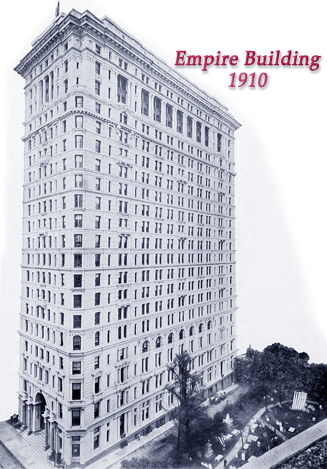
Lower Broadway
Lower Broadway extends from its origin at Bowling Green to City Hall Park. This section of Broadway is also called Canyon of Heroes, as it is the place where the city's ticker-tape parades have historically taken place since 1886, when the dedication of the Statue of Liberty was celebrated. For the section of Lower Broadway from Vesey Street to Chambers Street see Broadway at City Hall Park ►
During the Dutch rule, Broadway (then called Heeren Strast) originally extended from the old Fort Amsterdam to the walls of the old citadel at present-day Wall Street (see the 1695 John Miller' map). Beyond the city walls the road was known as "Heere Wegh". After the English took over the City, they changed the name to Broad Way and Fort Amsterdam, at the foot of Broadway, was renamed Fort James. The wall was removed in 1699 due to the expansion of the City of New York.
In the early 18th century, Broadway extended north to about present-day Vesey Street (see James Lyne' map). By mid-18th century, it was extended across the Common (now City Hall Park).
Many buildings in Lower Broadway were destroyed in the Great Fire of 1776, during the Independence War, including the first temple of Trinity Church, dedicated in 1697. The first temple of St. Paul's Chapel, built between 1764 and 1766, was also destroyed by the fire. The second temple of both churches were completed in 1790. In the Great Fire of 1845, a great number of buildings were also destroyed.
The second temple of Trinity Church was demolished in 1839 due to structural problems. The third and current temple was consecrated in 1846.
In the late 19th century, many of the early skyscrapers were built in Lower Manhattan, including the Western Union Telegraph Building (1875), Washington Building (One Broadway, 1885), Standard Oil Building (1885), Manhattan Life Building (1894), Bowling Green Offices (1898), Saint Paul Building (1898) and others.
More: Lower Broadway in the 19th Century ►
In 1908, the old 47-story Singer Building (149 Broadway), was completed on the northwest corner of Liberty Street. It was the tallest building in the world from 1908 to 1909, when it was surpassed by the Metropolitan Life Insurance Company Tower in New York. Singer Building was demolished in 1968 to make way for the 54-story U.S. Steel Building (now One Liberty Plaza). In 1913, Woolworth Building at 233 Broadway surpassed Metropolitan Life Tower as the world's tallest building. In 1930, it was surpassed by the 40 Wall Street. By the mid-20th century, Lower Broadway fell into decline, but a revival began in the 1980s.

◄ Broadway
Lower Broadway, looking Downtown. Vintage postcard by H.H. Tammen Company, about 1912. View taken from the Woolworth Building, showing the City Investing Building and Singer Building, on the right, and the Bankers Trust Company Tower and Saint Paul Building, on the left, among others.

Empire Building, at 71 and 73 Broadway, corner Rector Street. The American Express Building is to the left.
|
Copyright © Geographic Guide - Old NYC. Historic Places. |
Lower Broadway
